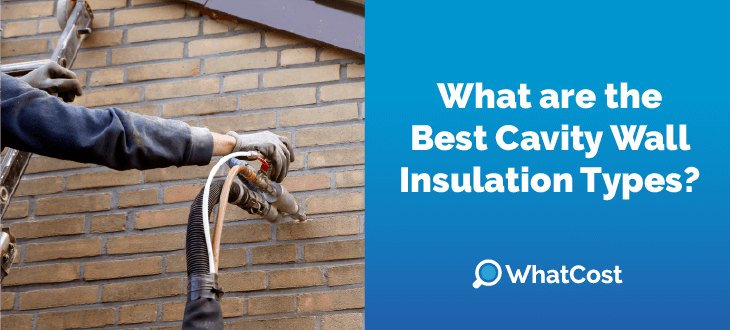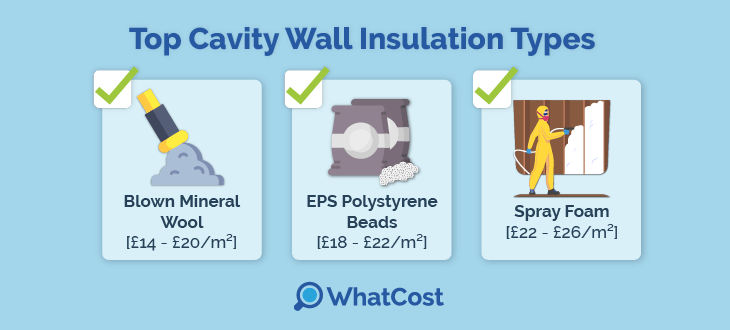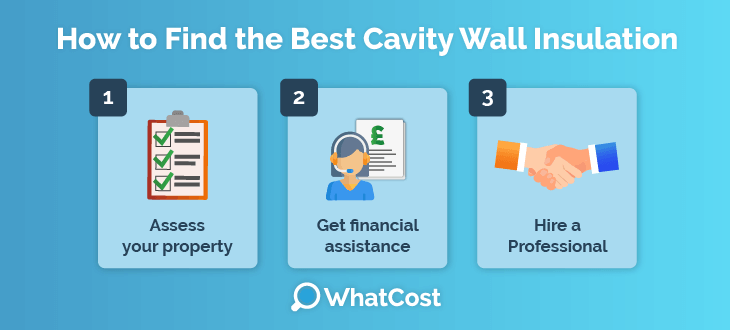Answer these simple questions and we will find you the BEST prices
Which type of solar quotes do you need?
It only takes 30 seconds
100% free with no obligation

Tell us what you need to find a matching specialist

Get free quotes from professionals near you

Compare offers and choose the one that best matches your need
- whatcost.co.uk
- Home Insulation
- Wall Insulation
- Cavity Wall Insulation
- Best Cavity Wall Insulation
Best Cavity Wall Insulation Types (2025)


- Cavity walls have an inside and outside leaf, with a hollow space in between. Insulation material is injected into the cavity space through drilled holes or during construction.
- Effective cavity wall insulation can save a detached UK home up to £410 in annual energy bills, and a staggering 1.1 tonnes in carbon emissions.
- Foam insulation is the most popular cavity wall insulation material, but there are far more sustainable and ecologically friendly alternatives to consider as the best material for cavity wall insulation.
Nearly three-quarters of UK homes have cavity walls, yet many remain inadequately insulated. This results in wasted heat production, leading to higher energy bills and increased carbon emissions, reflected in soaring energy bills. As a deterrent, insulating your home becomes very important.
Cavity wall insulation offers a highly effective and cost-efficient solution to improve your home's energy efficiency, reduce your environmental impact, and create a more comfortable living space. With various insulation materials available, choosing the best option for your home can seem overwhelming. This guide by WhatCost will explore the different types of cavity wall insulation, and their costs, and help you make an informed decision.
Ready to insulate your walls? Let WhatCost set you straight. It takes 30 seconds to fill out our online intake form, and we’ll send you up to 3 free home-tailored quotes directly from our nationwide network of pre-vetted professionals. No costs or obligations apply. Just click below to begin and secure your quotes today!
What are the different cavity wall insulation types?

While there is no single best insulation material as factors such as budget, performance and installation complexity play a role, there are three primary types of cavity wall insulation that are commonly used:
- Blown mineral wool: A cost-effective and sustainable option (£14 - £20/m²), mineral wool insulation is made from recycled materials and is itself recyclable. It's injected into the cavity but requires careful sealing to prevent moisture damage, which can compromise its effectiveness.
- EPS polystyrene beads: These small beads expand to fill the cavity space, offering excellent insulation and high recyclability at a moderate cost (£18 - £22/m²). While not a natural material, its sustainability and performance make it a strong contender.
- Spray foam: Providing superior thermal performance and mould resistance, spray foam creates an almost airtight seal, significantly reducing heat loss. However, it comes at a higher cost (£22 - £26/m²), is typically made from unsustainable materials (PUR/PIR), and can release harmful VOCs during installation.
Each material comes with its unique properties, cost ranges, and applications for which it is best suited. Understanding your cavity wall conditions will enable you to make the best choice.
Which cavity wall insulation type works best?
Your ideal choice of best cavity wall insulation will depend on a whole range of factors. For example, while spray foam might exhibit the best thermal resistance, mineral wool is the most sustainable.
To help you make the best choice, here’s a breakdown of the three most popular types of cavity wall insulation, and a breakdown of their key pros and cons:
- Blown mineral wool: A budget-friendly material with great thermal capacity, but very prone to absorbing moisture if the cavity isn't perfectly dry.
- EPS polystyrene beads: Easy to install, good moisture resistance, but lower thermal performance compared to some options.
- Spray foam: Excellent insulation value, fills gaps well, but more expensive and requires professional installation.
In addition to your chosen insulation material and its pros and cons, there are other key factors to consider when insulating walls, relating to your property conditions, common insulation problems and more:
- Cavity size and condition: The condition of your cavity space matters and can affect the efficiency of your insulation. A professional inspection is recommended to clean up any debris and repair any issues. Failure to do so can compromise any insulation material you end up installing.
- Moisture concerns: Stemming from the same need for a cavity wall inspection, moisture concerns can compromise most insulation materials. Mineral wool is the least ideal for moisture-prone walls whereas polystyrene beads or foam tend to offer better resistance.
Consulting a qualified insulation professional is crucial before deciding on the best insulation material for your specific cavity wall.
Best cavity wall insulation for old houses
For older homes with cavity walls, EPS polystyrene beads tend to represent the most suitable insulation choice. These beads offer excellent insulating properties while being highly resistant to moisture and mould, a crucial factor in older homes that are more susceptible to these issues.
Polystyrene beads are a more environmentally friendly alternative to spray foam, which can sometimes impede air circulation and exacerbate moisture problems due to its airtight seal. Mineral wool, while viable, can be more prone to moisture damage if not properly sealed.
Best cavity wall insulation for new build
Mineral wool insulation is often the most suitable choice for new build cavity wall insulation. These homes typically have undamaged cavities and are well-sealed, thus minimising the risk of moisture ingress that can degrade some insulation materials.
Mineral wool also provides excellent thermal insulation while being far more cost-effective compared to other options like spray foam. This allows for high energy efficiency without significantly increasing construction costs.
Cavity wall insulation types to avoid damp
When it comes to minimising the risk of insulation dampness, EPS polystyrene beads emerge as the best type of cavity wall insulation. Their inherent resistance to moisture and mould growth ensures long-lasting insulation performance without degradation from damp conditions and weathering.
In comparison, spray foam may also offer great moisture resistance, but its lack of breathability can lead to moisture buildup and ingress within the cavity walls. Spray foam can also have a significant environmental impact due to its chemical composition and manufacturing processes.
Which cavity wall insulation type is best for you?

Selecting the most suitable cavity wall insulation for your home depends on a variety of factors, including your budget, desired level of insulation effectiveness, and environmental concerns. This is hardly a ‘one size fits all’ matter and careful consideration is required.
- Assess your property: Hiring a professional insulation expert to assess your property walls is a huge win. It’ll enable you to pay for a home-tailored plan that is specifically designed to meet your needs at the lowest cost margin and highest professional level. While a DIY installation may seem tempting in the short term, a poor job can quickly become a financial nightmare.
- Gauge financial assistance: If the cost of cavity wall insulation seems hard to surmount, you can explore cavity wall insulation grants that are available in the UK. Programs like the GBIS and ECO4 can assist low-income and fuel-poor households with insulation upgrades.
- Hire a professional: Cavity wall insulation is a complex procedure that should always be handled by a qualified professional. DIY attempts are strongly discouraged as the process involves specialized equipment and techniques.
By carefully considering your needs and budget, and choosing a reputable installer, you can ensure that your home benefits from effective and long-lasting cavity wall insulation. However, finding the right installer can take countless hours of research and vetting, so why not let WhatCost handle it for you?
Through our services, all it takes is 30 seconds to fill out our simple online form. In return, you’ll receive up to 3 free home-tailored quotes directly from our network of trusted installers. No costs, no obligations. Simply click the button below and let the bargains come to you!
FAQ
There are three main types of cavity wall insulation materials, such as blanket-style insulation (mineral wool), EPS polystyrene beads, and spray foam. Each comes with its unique properties, cost ranges, pros, and cons to consider.
There is no single best cavity wall insulation material, as your choice will depend on factors such as your wall conditions, budget, and preferences. For example, spray foam insulation provides the best thermal resistance, but mineral wool is more breathable and sustainable. Consulting with a professional installer can help make the best choice.
The best cavity wall insulation to avoid dampness issues would be EPS polystyrene. This is because mineral wool is far too prone to moisture ingress and spray foam insulation can collect moisture due to its impenetrable airtight seal that does not allow for evaporation.
The most sustainable cavity wall insulation materials are blanket-style insulators such as mineral wool or fibreglass. These materials are made from recycled rock or glass, woven into blankets which can also be endlessly recycled after use.
The best cavity wall insulation for an old house is EPS polystyrene beads. This is because they are the most durable against moisture and weathering, issues that are far more common with older homes.

Akif has a keen interest in green home improvement solutions and the role of digital media in identifying climate trends. He aims to provide a multidisciplinary approach to content rooted in credible research and accuracy.
- Best Cavity Wall Insulation Types (2025)
- What are the different cavity wall insulation types?
- Which cavity wall insulation type works best?
- Best cavity wall insulation for old houses
- Best cavity wall insulation for new build
- Cavity wall insulation types to avoid damp
- Which cavity wall insulation type is best for you?
- FAQ
